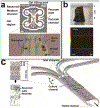Integrating Mass Spectrometry with Microphysiological Systems for Improved Neurochemical Studies
- PMID: 30148282
- PMCID: PMC6103221
- DOI: 10.21037/mps.2018.05.01
Integrating Mass Spectrometry with Microphysiological Systems for Improved Neurochemical Studies
Abstract
Microphysiological systems, often referred to as "organs-on-chips", are in vitro platforms designed to model the spatial, chemical, structural, and physiological elements of in vivo cellular environments. They enhance the evaluation of complex engineered biological systems and are a step between traditional cell culture and in vivo experimentation. As neurochemists and measurement scientists studying the molecules involved in intercellular communication in the nervous system, we focus here on recent advances in neuroscience using microneurological systems and their potential to interface with mass spectrometry. We discuss a number of examples - microfluidic devices, spheroid cultures, hydrogels, scaffolds, and fibers - highlighting those that would benefit from mass spectrometric technologies to obtain improved chemical information.
Conflict of interest statement
Conflict of Interest The authors declare no conflict of interest.
Figures



References
-
- Huang S, Wikswo J. Dimensions of Systems Biology Reviews of Physiology Biochemistry and Pharmacology. Berlin, Heidelberg: Springer; 2007. p. 81–104. - PubMed
-
- Baharvand H, Hashemi SM, Kazemi Ashtiani S, et al. Differentiation of Human Embryonic Stem Cells into Hepatocytes in 2D and 3D Culture Systems in Vitro. Int J Dev Biol 2006;50:645–52. - PubMed
Grants and funding
LinkOut - more resources
Full Text Sources
Other Literature Sources
Research Materials
